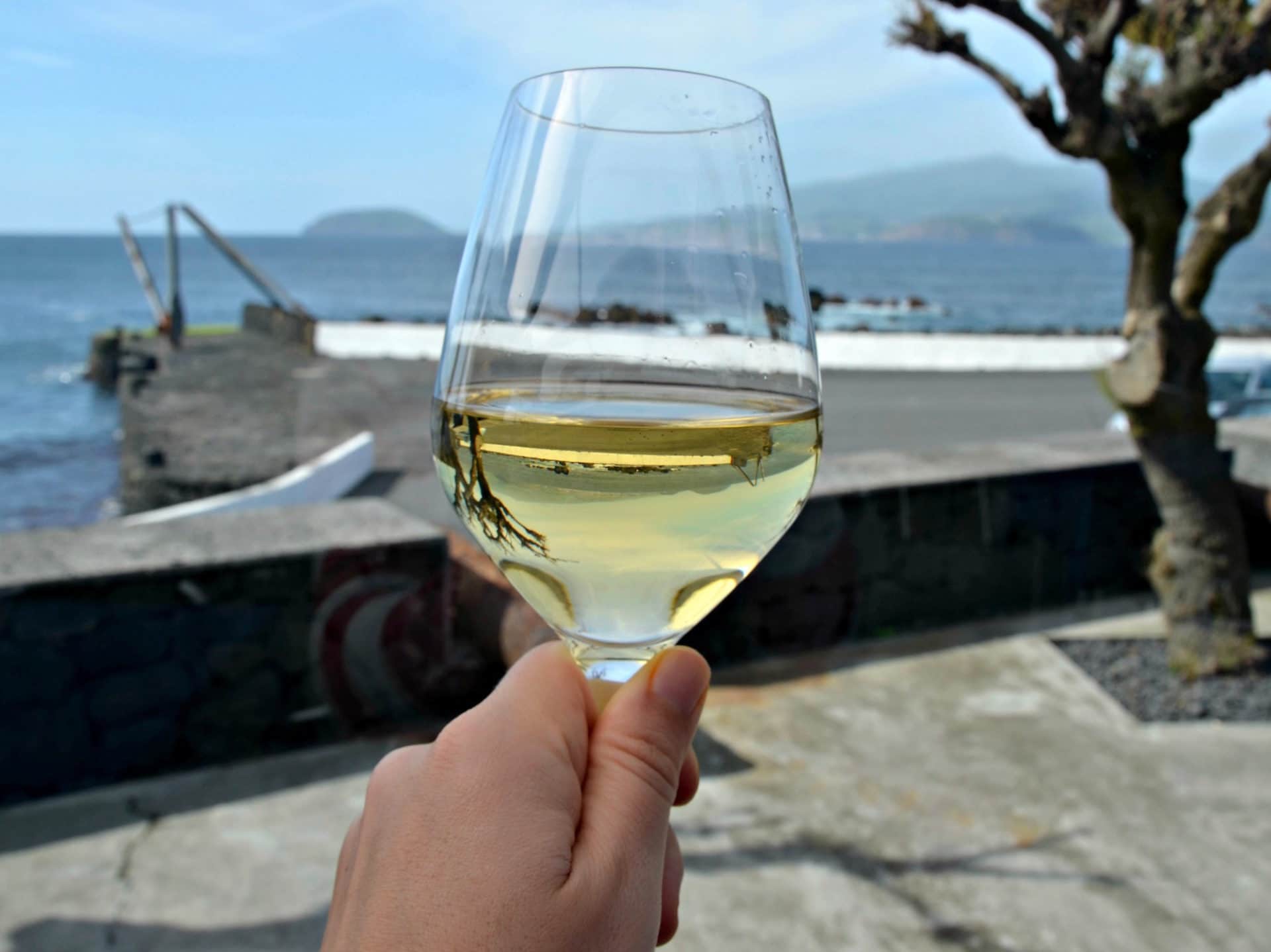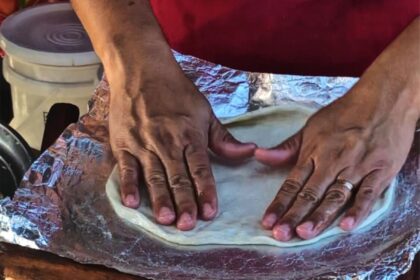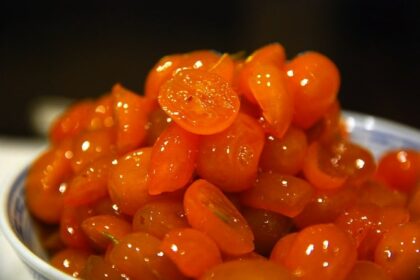Pico Island, one of nine volcanic Azorean islands located almost 1,000 miles from mainland Portugal, isn’t the first place you’d expect to find a thriving wine culture; however, the destination has been producing wine since the 15th century, starting about 10 years after the first settlers came around 1439. Despite volcanic eruptions, lava landslides and hostile environment, these early settlers were able to not only adapt, but thrive.
If you’re picturing endless parallel rows of vines sprouting from grassy countryside, think again. Because this is a volcanic island, vintners adapted to the basalt-littered landscape. The stone homes and stone-walled vineyards to protect the 2,439 acres of vineyard from fierce Atlantic winds and surges of salty ocean water from hundreds of years ago can still be seen today in the UNESCO World Heritage-listed Criação Velha wine region, in the municipality of Madalena.
It’s quite a sight, vines growing from lava soil and flourishing on the rock. The black basalt has a tendency to absorb and give back heat, which leads to grapes ripe with sugar. What’s interesting is that while the walls protect from sea breezes, take one sip of wine and you’ll know you’re near the water, the unique terroir so alive you can taste the ocean through the fresh yet salty bouquet and high minerality.
The small plots of land these 5-foot high walls protect are known as “currais,” and myriad together form a complex labyrinth of rectangular pens quite spectacular to see from above or to walk through.
In Criação Velha, the focus is less on modern grapes and more on the traditional grapes of verdelho, (introduced by the Flemish), arinto (typically used for sparkling and blends) and terrantez (known for its ability to produce sweet and fortified wines). Rocky, volcanic, mineral-rich soils allow for good internal drainage, while the cool climate aids in creating great whites and light-bodied reds, as well as wines from a number of other grape varieties that have made their way to the Azores over the years.
According to my local guide, Ana of Abegoaria Adventure, you’ll find Pico Island’s most extensive network of vineyards here. As I wander through old world setting, basalt mixing with grapes as far as the eye can see, I believe her.

Pico Island Wine History
To truly understand Pico Island wine, it’s important to go back in time. Franciscan friars are believed to be the first to make wine here in the 15th century, turning verdelho grapes into fortified wine. The wine was said to be so good, after Czar Nicholas II of Russia was executed it was found in his cellar.
Like much of Europe, Pico Island suffered from the spread of vine diseases like oidium and phylloxera from 1850, turning to disease-resistant grapes in the USA. It wasn’t until the 1990s they were able to again grow their traditional grapes, and today the fortified verdelho wine enjoys a special Vinho Licoroso de Qualidade Produzido em Região Determinada (VLQPRD), or “quality liqueur wine produced in a specific region” status.
Experience Pico Island Wine
After climbing up a giant windmill for an aerial shot of the vineyards, we head up the street to Ancoradouro Restaurante, where they not only make their own wine — their house white has a nice acidity and delicious notes of green apple and grapefruit — but you can pair it with Atlantic Ocean views on an outdoor patio. Savored with some fresh catch and a slice of Pudim Mel, or honey pudding, a sort of pie with sugar crisp crunch made from a simple recipe of sugar, local honey, eggs and cinnamon, it’s the perfect afternoon in the Old World.
Across the street from the restaurant is one of Pico Island’s most important attractions for wine lovers: the Cooperativa Vitivinícola da Ilha do Pico (Pico Island Wine Cooperative), where 230 associates work with 500 tons of European grapes each year. Here, guests can partake in tastings from labels like Terras de Lava, Frei Gigante and Basalto, take tours and learn from workshops, educating themselves on local viticulture through the palate. While I learned about Portuguese wines in my sommelier studies, here I’m educated about Pico’s wines specifically.
It was the wine cooperative, founded in 1949, that began restoring the basalt walls hurt by vine diseases, and in 1965 the first Pico Aperitivo hit the market, a high acid white wine with a fruity bouquet made from verdelho grapes.
Back in the car, I drive another 10 minutes to reach Cachorro, an important place for understanding Pico Island’s wine heritage. The ocean is lined with historic but still-in-use Coast Places, small black basalt buildings with shallow clay roofs used seasonally to make wine and store barrels, with handmade stone barrel ramps leading from them to the port. They also allow winemakers to be near their vineyards from June to early October.
I can’t help but take notice of the unusual dog sculpture carved into the rock wall separating the homes from the water, paying homage to the local claimed that when water approached the dock the vintners saw a dog’s face. In summer, you can stop in the cozy Alda Maria Freitas Costa to buy bottles of local wines and savor free samples of fruit liqueurs they make themselves.
Continuing on another 10 minutes is Lajido, a must-visit if you want to immerse yourself in a world of old houses from the 15th century vintners. The homes are simple constructions made from stone without use of concrete, featuring small glass windows and red and green doors to signify a poor or wealthy social class, respectively.
There’s a distillery-slash-museum worth checking out to see how they make liquors and fire water using timeless stone machines. It’s interesting to note how timeless hundreds-of-years-old-machines are still used today, showing the ingenuity of the early settlers.
For a bit of outdoor adventure, Cabrito features original vintner homes and coast-meets-vineyard treks that take you along a cliff edge above the water. As waves crash against rock on one side, the signature basalt maze formations of the local vineyards are on the other. Look down, and you’ll see tracks from old mule carts that once transported wine barrels imprinted into the hardened lava beneath your feet.
My day exploring Pico Island’s drink culture ends at Adega A. Buraca in San António, a distillery, tasting room and event space where the Silva family have been producing distilled aguardente and fruit liqueurs since 2007 in an old world fashion, even bottling by hand.
If you want to do a libation tasting simply show up; however, you can also have a meal and/or snacks arranged for pairing if you make a reservation in advance. A small onsite museum provides a glimpse into traditional wine-making and distilling, while a shop sells their homemade products and local handicrafts.
The Future Of Pico Wines
So, what’s in store for the future of Pico wines? While of high quality and grown in an extremely interesting island setting in the middle of nowhere, this also makes these wines difficult to be shipped. It also means they remain largely undiscovered. This may change, but for now Pico wines are a local Azores specialty — just one more reason to visit the islands for yourself.
Oh, and here’s one more:
If you’re interested in exploring responsible travel in Portugal, you’ll be happy to know that the Azores is the world’s first archipelago certified as a Sustainable Tourism Destination under the EarthCheck Sustainable Destination program.
Have you visited Pico Island in the Azores?
Logistics:
Ancoradouro Restaurante, Rua Rodrigo Guerra, N7-Areia Large, 9950-302 Madalena do Pico; +351 292 623 490
Pico Island Wine Cooperative, Avenida Padre Nunes de Rosa #29, Madalena; +351 292 622 262, [email protected]
Adega A Buraca, Estrada Regional #35, 9940 Santo António; +351 292 642 119
Alda Maria Freitas Costa, R. D. Jaime Garcia Goulart; +351 292 622 418
Enjoyed this post? Pin it for later!

Jessica Festa
Latest posts by Jessica Festa (see all)
- A Culturally-Immersive Adventure In Mongolia’s Altai Mountains - Jul 8, 2023
- This Recipe Sharing Platform Supports Women In The Culinary Industry (Labneh Recipe Included!) - Nov 5, 2020
- Hiking The Mohare Danda Community Eco-Trek In Nepal - Jun 3, 2020
- 6 Important Questions For Choosing A Responsible Yoga Retreat - May 18, 2020
- How To Create & Grow A Profitable Blogging Business (Ethically) - Jan 18, 2020



















It’s been said that in the Azores they float brandy on top of wine kegs then set the brandy on fire, to see if the wine is “ready.” If so, by whom? Why is it done?